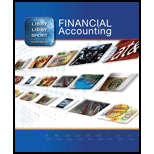
Financial Accounting, 8th Edition
8th Edition
ISBN: 9780078025556
Author: Robert Libby, Patricia Libby, Daniel Short
Publisher: McGraw-Hill Education
expand_more
expand_more
format_list_bulleted
Textbook Question
Chapter 5, Problem 2P
Matching Definitions with
Following are terms related to the balance sheet that were discussed in Chapters 2 through 5. Match each definition with its related term by entering the appropriate letter in the space provided.
| Terms | Definitions |
| _ (1) Capital in excess of par _ (2) Assets _ (3) _ (4) Book value - (5) Other assets _ (6) Shares outstanding _ (7) Shareholders' equity _ (8) Liquidity _ (9) Normal operating cycle _(10) Current assets _ (11) Current liabilities _ (12) Long-term liabilities _ (13) Fixed assets _ (14) Liabilities _ (15) Contra-asset account _ (16) _ (17) intangible assets |
|
Expert Solution & Answer
Want to see the full answer?
Check out a sample textbook solution
Students have asked these similar questions
Using the results of the Top 5 Customers by Accounts Receivable Amount Due and the Top 5
Customers by Outstanding Sales Order Amount visualization, what conclusion can be made
regarding the outstanding sales orders?
a. The high value of outstanding accounts receivable for Sanders Corp may be directly
related to their high value of outstanding sales orders.
b. The high value of outstanding accounts receivable for Williams Corp may be directly
related to their high value of outstanding sales orders.
c. The high value of outstanding sales orders for Roberts Corp has caused them not to pay a
large value of invoices.
d. Evans Corp has a high value of outstanding accounts receivable and outstanding sales
orders.
Based on the dashboard, what recommendations would you give to improve the overall sales
and revenue of Borders USA?
Is there any additional information would you like to have to provide useful
recommendations?
What are your interpretations of AR Aging and Sales Order Aging dashboards?
1. Using the Sales vs Revenue by Quarter in 2022 visualization, what trends are being shown
between sales and revenue?
a. Sales was variable for each quarter, but revenue decreased every quarter.
b. Sales decreased every quarter, but revenue was variable for each quarter.
c. Revenue was higher than sales for each quarter.
d. Revenue was lower than sales for only the first two quarters.
Chapter 5 Solutions
Financial Accounting, 8th Edition
Ch. 5 - Prob. 1QCh. 5 - Prob. 2QCh. 5 - Prob. 3QCh. 5 - Explain what a material amount is.Ch. 5 - What basis of accounting (cash or accrual) does...Ch. 5 - Prob. 6QCh. 5 - Prob. 7QCh. 5 - Prob. 8QCh. 5 - Prob. 9QCh. 5 - For property, plant, and equipment, as reported on...
Ch. 5 - Briefly explain the major classifications of...Ch. 5 - Prob. 12QCh. 5 - Prob. 13QCh. 5 - Prob. 14QCh. 5 - If average total assets increase, but net income,...Ch. 5 - Prob. 2MCQCh. 5 - Prob. 3MCQCh. 5 - Prob. 4MCQCh. 5 - Prob. 5MCQCh. 5 - Prob. 6MCQCh. 5 - Prob. 7MCQCh. 5 - Prob. 8MCQCh. 5 - Prob. 9MCQCh. 5 - Prob. 10MCQCh. 5 - Prob. 1MECh. 5 - Prob. 2MECh. 5 - Prob. 3MECh. 5 - Prob. 4MECh. 5 - Determining Financial Statement Effects of Sales...Ch. 5 - Prob. 6MECh. 5 - Prob. 7MECh. 5 - Matching Players in the Accounting Communication...Ch. 5 - Prob. 2ECh. 5 - Finding Financial Information: Matching...Ch. 5 - Prob. 4ECh. 5 - Preparing a Classified Balance Sheet Campbell Soup...Ch. 5 - Prob. 6ECh. 5 - Prob. 7ECh. 5 - Prob. 8ECh. 5 - Prob. 9ECh. 5 - Prob. 10ECh. 5 - Prob. 11ECh. 5 - Stock Issuances and the Statement of Stockholders...Ch. 5 - Prob. 13ECh. 5 - Prob. 14ECh. 5 - Prob. 15ECh. 5 - Prob. 16ECh. 5 - Prob. 17ECh. 5 - Prob. 18ECh. 5 - Prob. 19ECh. 5 - Prob. 1PCh. 5 - Matching Definitions with Balance Sheet-Related...Ch. 5 - Prob. 3PCh. 5 - Prob. 4PCh. 5 - Preparing a Classified (Multiple-Step) Income...Ch. 5 - Prob. 6PCh. 5 - Determining and Interpreting the Effects of...Ch. 5 - Determining the Effects of Transactions on Ratios...Ch. 5 - Prob. 9PCh. 5 - Prob. 1APCh. 5 - Prob. 2APCh. 5 - Prob. 3APCh. 5 - Prob. 4APCh. 5 - Prob. 1CPCh. 5 - Prob. 2CPCh. 5 - Prob. 3CPCh. 5 - Prob. 4CPCh. 5 - Prob. 5CPCh. 5 - Prob. 6CPCh. 5 - Prob. 7CPCh. 5 - Evaluating the Impact of Transactions on Statement...Ch. 5 - Prob. 2CC
Knowledge Booster
Learn more about
Need a deep-dive on the concept behind this application? Look no further. Learn more about this topic, accounting and related others by exploring similar questions and additional content below.Similar questions
- I need help with this financial accounting problem using accurate calculation methods.arrow_forwardCan you provide the valid approach to solving this financial accounting question with suitable standards?arrow_forwardPlease explain the accurate process for solving this financial accounting question with proper principles.arrow_forward
arrow_back_ios
SEE MORE QUESTIONS
arrow_forward_ios
Recommended textbooks for you
 Financial Accounting: The Impact on Decision Make...AccountingISBN:9781305654174Author:Gary A. Porter, Curtis L. NortonPublisher:Cengage Learning
Financial Accounting: The Impact on Decision Make...AccountingISBN:9781305654174Author:Gary A. Porter, Curtis L. NortonPublisher:Cengage Learning Cornerstones of Financial AccountingAccountingISBN:9781337690881Author:Jay Rich, Jeff JonesPublisher:Cengage LearningPrinciples of Accounting Volume 1AccountingISBN:9781947172685Author:OpenStaxPublisher:OpenStax College
Cornerstones of Financial AccountingAccountingISBN:9781337690881Author:Jay Rich, Jeff JonesPublisher:Cengage LearningPrinciples of Accounting Volume 1AccountingISBN:9781947172685Author:OpenStaxPublisher:OpenStax College

Financial Accounting: The Impact on Decision Make...
Accounting
ISBN:9781305654174
Author:Gary A. Porter, Curtis L. Norton
Publisher:Cengage Learning

Cornerstones of Financial Accounting
Accounting
ISBN:9781337690881
Author:Jay Rich, Jeff Jones
Publisher:Cengage Learning

Principles of Accounting Volume 1
Accounting
ISBN:9781947172685
Author:OpenStax
Publisher:OpenStax College
ACCOUNTING BASICS: Debits and Credits Explained; Author: Accounting Stuff;https://www.youtube.com/watch?v=VhwZ9t2b3Zk;License: Standard Youtube License